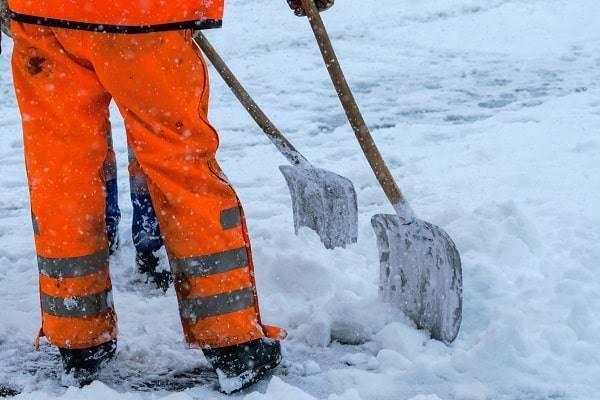For the next few months, many parts of the country face winter weather that includes extremely low temperatures, large amounts of snowfall and bitter winds. While offering employees an opportunity to warm up with a hot cup of cocoa after being outside is nice, it’s important to ensure workers exposed to the
winter elements remain protected at all times. Even if they’re only outside for a short time period, a lack of preparation can increase the risk of injury.
Cold Weather Safety Tips for Employees Working in Winter Weather
 OSHA
OSHA has identified some of the most common winter weather hazards, as well as the steps to take to help protect outdoor workers this time of year:
Slips and falls due to snow or ice
Working outdoors in cold weather can mean walking on slippery pavement or loading docks. Plus, employees may track in snow, ice and mud as they enter buildings. Keep
walkways and
parking lots as clear of snow and ice as possible by using de-icer immediately following a storm. Employees should wear proper footwear that is not only well-insulated and water-resistant, but that also has thick, rubber soles with good treads. If working on icy walking surfaces is unavoidable, or likely, slip-on metal cleats may be a good footwear accessory to consider.
Cold stress from exposure to cold air temperatures
When an employee’s skin temperature decreases, eventually the internal body temperature decreases, too, causing conditions like frostbite or hypothermia. Whenever possible, schedule outdoor tasks for the warmest part of the day and provide heated areas out of the wind to use during break periods so workers have ample time to recover from the cold. Additionally, employees should wear layers of clothing to protect them from the elements, including an inner layer of clothing that can absorb moisture and an outer layer consisting of a waterproof, windproof and durable coat. Make sure they also wear insulated hats, thick gloves, wool socks and well-fitted boots. For work that is necessarily outdoors, provide a break area that is out of the wind and warmed, so workers can seek refuge from the cold and recover.

Loss of power and communication disruption
During a winter storm, it’s not uncommon for many facilities to lose power, which often can lead to a disruption in communication practices. You wouldn’t want your valuable employees to show up on a job site that could be dangerous, so set up a phone tree with employees so they can be made aware of power outages that could impact their work for the day.
Winter driving
Icy road conditions are responsible for
24% of all weather-related vehicle crashes, with 15% occurring when it’s snowing or sleeting. If
winter driving is an essential part of your employees’ roles, they should watch the weather forecast to stay on top of any potential storms on the way and plan their routes accordingly. While it’s impossible to control the condition of the roads, making smart decisions and properly preparing for the weather can help reduce the risk of accidents. It’s a good idea to pack a winter-survival kit in vehicles, so if the vehicle slides off the road or becomes stuck in a snow bank, occupants of the vehicle can survive until help arrives.
Shoveling snow and using snow blowers
While shoveling snow can be extremely taxing on the body and lead to dehydration and back injuries, snow blowers can also be dangerous to outdoor workers. They frequently cause lacerations or even amputations, and can also lead to electric shock when not grounded properly. Workers should take frequent breaks from shoveling and rest in a warm area. They should also understand proper shoveling techniques, like pushing snow instead of lifting it whenever possible and bending and lifting from the legs, not the back. When using snow blowers, never attempt to clear a jam by hand. Instead, after turning it off, wait for all moving parts to stop, and then use a long stick to clear debris or jams. Also, ensure all powered equipment is properly grounded before using.
Downed power lines and trees
It should always be assumed that downed power lines are energized, so only qualified workers should go anywhere near them, especially because the moisture from snow can reduce the effectiveness of equipment designed to protect from electrocution. Make sure to establish a safe distance from any damaged power lines, including those around fallen trees, and report incidents immediately to properly-trained electrical workers.

Working at heights
Another common winter weather hazard involves those employees who are required to work on roofs or other high surfaces. A roof may be structurally unsafe due to the weight of the snow or ice covering it. Workers are also at risk of hazards like walking on unseen skylights, increased slippery surfaces or overhead power lines. It’s always important to determine if additional equipment is needed to remove snow or ice from heights, like aerial lifts or non-slip safety boots, as well as properly training all outdoor workers on how to use them. Whenever possible, reschedule roof or other high work until snow and ice are not present.
Loss Control from AmTrust Financial
AmTrust’s
Loss Control Department knows that access to the right
safety resources and commercial property safeguards are keys to a successful business. We can give you the individual attention you deserve, identifying specific hazards and offering recommendations that fit your operation. For more information, please
contact us today.
This material is for informational purposes only and is not legal or business advice. Neither AmTrust Financial Services, Inc. nor any of its subsidiaries or affiliates represents or warrants that the information contained herein is appropriate or suitable for any specific business or legal purpose. Readers seeking resolution of specific questions should consult their business and/or legal advisors. Coverages may vary by location. Contact your local RSM for more information.